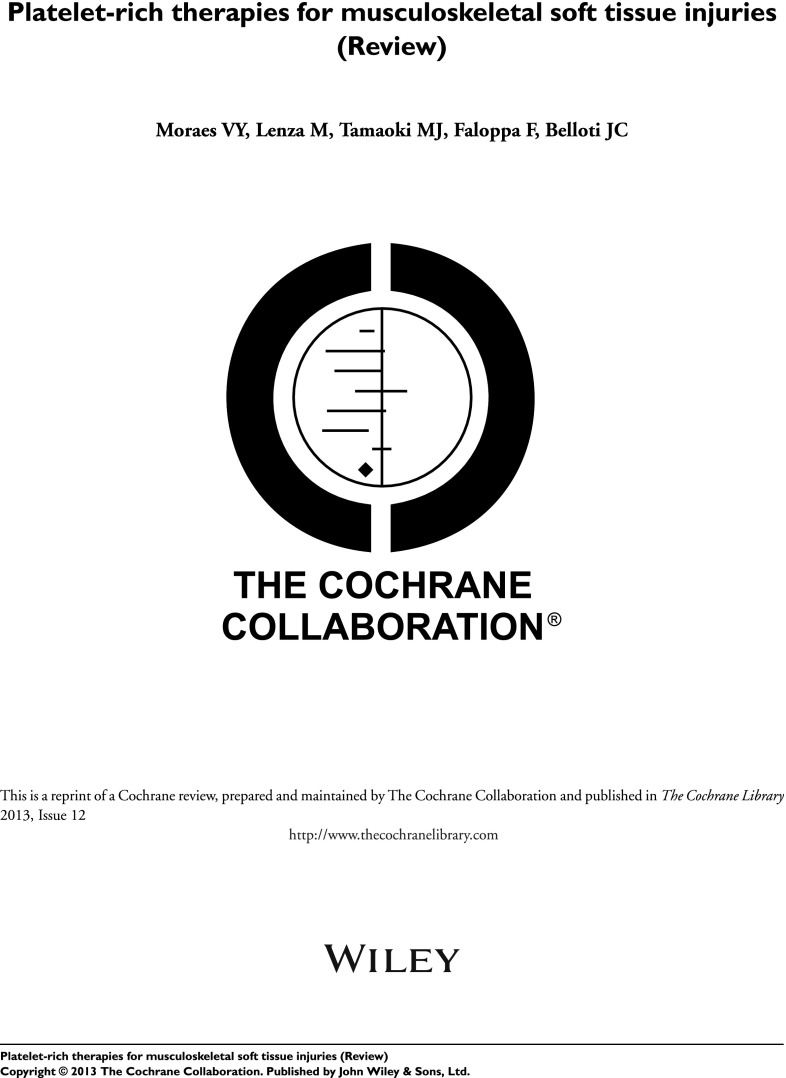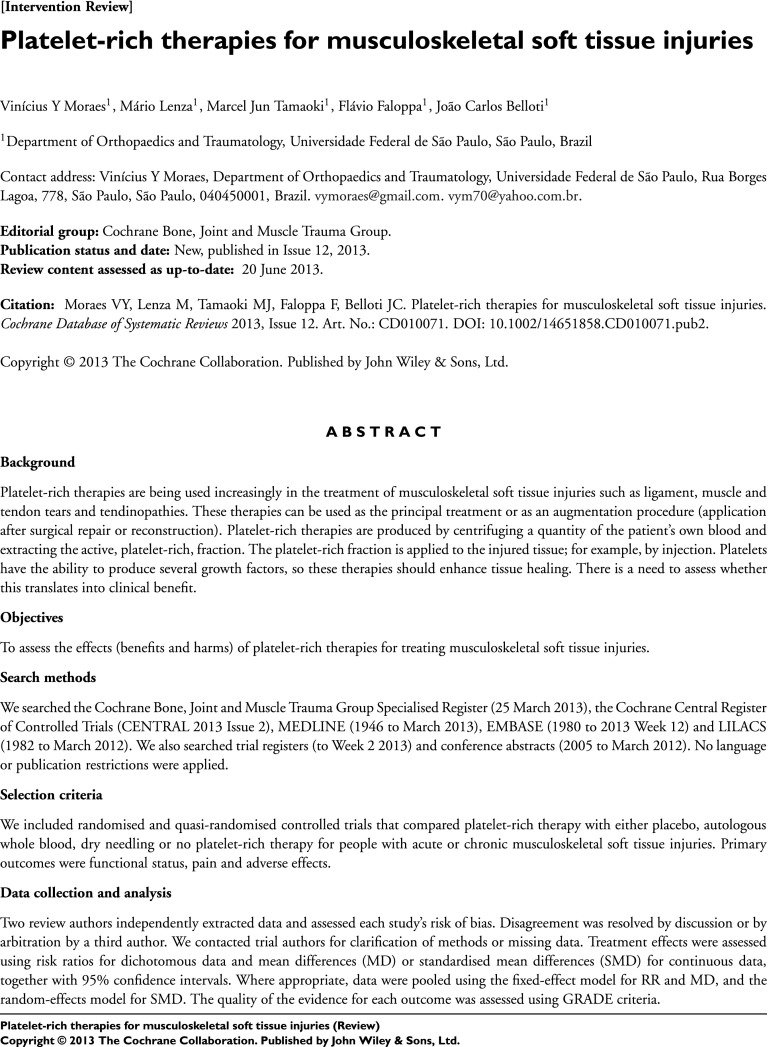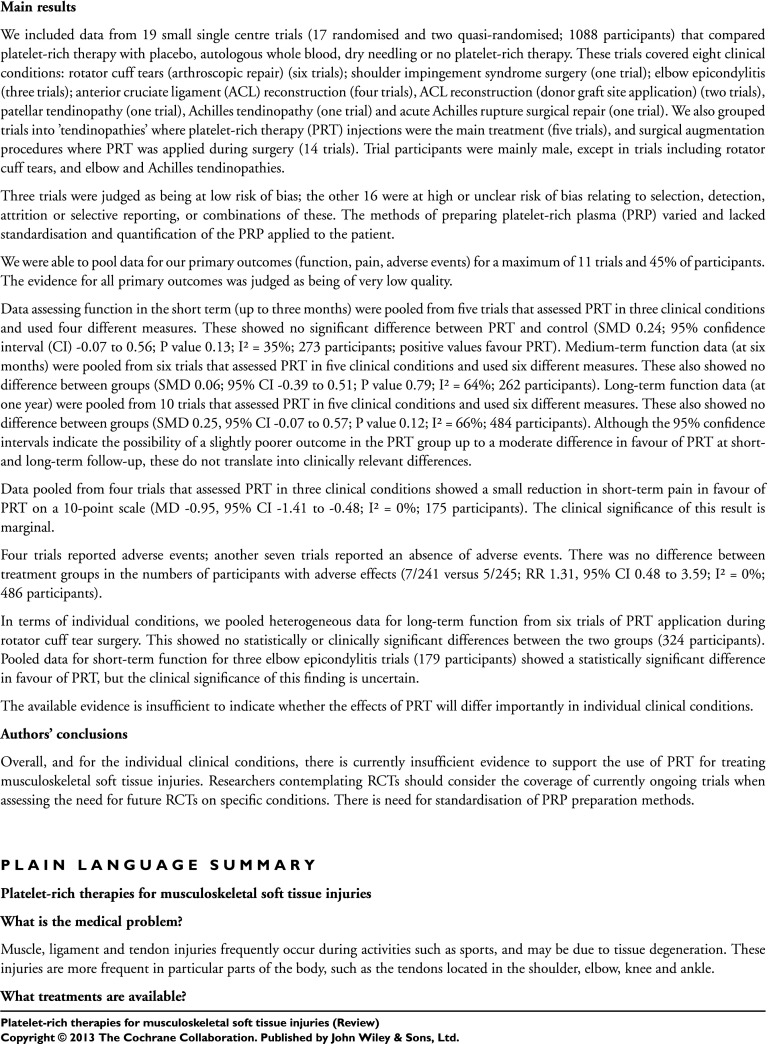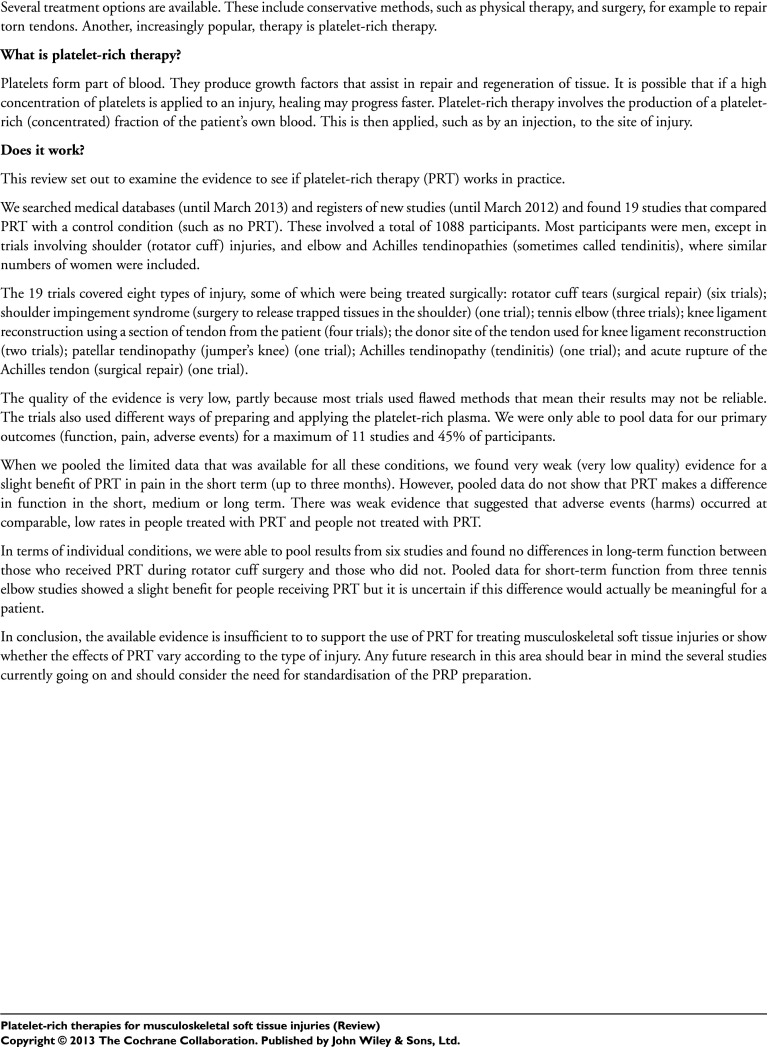Importance of the Topic
Soft tissue injuries represent more than 50% of all musculoskeletal injuries reported each year in the United States [8]. The diagnosis and management of such injuries represent a substantial financial burden, estimated at more than USD 15.8 billion annually [6]. The use of autologous blood concentrates, particularly platelet-rich plasma (PRP), has exponentially grown as a result of significant media attention and use among high-level athletes [9]. While originally used to manage dermatologic and oromaxillofacial conditions, musculoskeletal applications related to bone and soft tissue injury have become widespread [9]. The market for PRP was valued at USD 45 million in 2009 and is expected to be worth more than USD 120 million by 2016 [7].
PRP is defined as a sample of autologous blood with supraphysiological concentrations of platelets [2]. Once activated, platelets release bioactive proteins and growth factors that are thought to aid and promote healing [2], but there is substantial controversy regarding their efficacy [3]. Rigorous evaluation of the available evidence can inform clinicians regarding optimal treatment options for patients. This Cochrane review evaluated all randomized and quasi-randomized controlled trials (19 trials, 1088 patients), of PRP versus placebo, autologous whole blood, dry needling, or no PRP therapy across eight clinical indications.
Upon Closer Inspection
Heterogeneity can be qualified as either clinical or methodological. The former is defined as variability among studies with regards to participants, interventions, and outcomes and the latter relates to variability in study design and risk of bias [1]. The presence of either of these can result in variability in the intervention effect across studies beyond that which might be expected due to chance alone, which is known as statistical heterogeneity [1]. High-quality meta-analysis should present and evaluate the ways in which results differ between studies. The reader can then judge and explore the reasons for variance in the results and the degree to which the difference influences his or her ability to use the conclusions derived from data pooling [5]. Such exploration and direction of anticipated effect should be specified a priori to reduce the risk of potentially arriving at spurious correlations [10].
A major confounding factor identified in this review of PRP is the heterogeneity of the included studies, particularly with chronicity of injuries, timing of interventions, outcomes reported, and most importantly, a lack of standardization in the application of PRP. More than 40 commercial PRP systems are available and each product may contain differing concentrations of platelets, leukocytes, and growth factors [2]. Included studies varied in the timespan between PRP preparation and delivery, method of delivery (image, arthroscope, direct vision, or no guidance), number of PRP applications, and postoperative cointerventions [4]. Variability in the intervention, as identified by the study authors, may bias the results (eg, comparing preparations with high platelet concentrations versus those with low concentrations). Overall, the evidence was considered low quality, given the uncertainty related to estimates of effect, according to the GRADE approach.
Selective reporting was also identified by the study authors as a potential bias in this review. Of the 19 included trials, 11 did not provide a priori protocol or trial registration details for the study, which may bias results in favor of the intervention. Research transparency is improved through publication of such details and allows for identification of selective reporting such as adverse events or surrogate outcomes, which may not be clinically relevant.
Take-home Messages
This Cochrane systematic review and meta-analysis found no benefit attributable to PRP for short-, medium-, or long-term function. Short-term improvements in pain were identified but the effect sizes were small, and unlikely to be clinically important. These results are similar to other recent systematic reviews and meta-analyses on this subject [9]. This review of best available evidence adds to our understanding that PRP use for musculoskeletal soft tissue injuries is currently unsupported.
This review highlights the difficulty with assessment of the efficacy of PRP interventions in orthopaedics and leaves open the possibility that indeed they are not effective. Factors include the lack of standardization and substantial variations in the concentration of platelets and growth factors among available commercial PRP systems [2]. Furthermore, the most efficacious platelet concentrations are not known, dose-response curves are not linear, saturation effects have been described, and the ideal timing of intervention and elution kinetics of growth factors require further evaluation [2]. Current evidence is not sufficient to conclude that PRP provides clear clinical benefit and augmentation of soft tissue healing. Further research through large methodologically rigorous trials with standardized PRP preparations are required to improve understanding related to indications for PRP.
Appendix
Footnotes
A Note from the Editor-In-Chief: We are pleased to publish the next installment of Cochrane in CORR ® , our partnership between CORR ® , The Cochrane Collaboration ® , and McMaster University’s Evidence-Based Orthopaedics Group. In it, researchers from McMaster University will provide expert perspective on an abstract originally published in The Cochrane Library that we think is especially important.
(Moraes VY, Lenza M, Tamaoki MJ, Faloppa F, Belloti JC. Platelet-rich therapies for musculoskeletal soft tissue injuries. Cochrane Database of Systematic Reviews 2013, Issue 12. Art. No.: CD010071. DOI: 10.1002/14651858.CD010071.pub2.)
Copyright © 2013 The Cochrane Collaboration. Published by John Wiley & Sons, Ltd. Reproduced with permission.
All ICMJE Conflict of Interest Forms for authors and Clinical Orthopaedics and Related Research® editors and board members are on file with the publication and can be viewed on request.
The opinions expressed are those of the writers, and do not reflect the opinion or policy of CORR® or the Association of Bone and Joint Surgeons®.
Cochrane Reviews are regularly updated as new evidence emerges and in response to feedback, and The Cochrane Library (http://www.thecochranelibrary.com) should be consulted for the most recent version of the review.
This Cochrane in CORR® column refers to the abstract available at: DOI: 10.1002/14651858.CD010071.pub2.
References
- 1.Higgins JPT, Green S, eds. Cochrane handbook for systematic reviews of interventions Version 5.1.0 [updated March 2011]. Available at http://handbook.cochrane.org/. Accessed February 12, 2015.
- 2.Hsu WK, Mishra A, Rodeo SR, Fu F, Terry MA, Randelli P, Canale ST, Kelly FB. Platelet-rich plasma in orthopaedic applications: Evidence-based recommendations for treatment. J Am Acad Orthop Surg. 2013;12:739–748. doi: 10.5435/JAAOS-21-12-739. [DOI] [PubMed] [Google Scholar]
- 3.Lee KS, Wilson JJ, Rabago DP, Baer GS, Jacobson JA, Borrero CG. Musculoskeletal applications of platelet-rich plasma: Fad or future? AJR Am J Roentgenol. 2011;3:628–636. doi: 10.2214/AJR.10.5975. [DOI] [PubMed] [Google Scholar]
- 4.Moraes VY, Lenza M, Tamaoki MJ, Faloppa F, Belloti JC. Platelet-rich therapies for musculoskeletal soft tissue injuries. Cochrane Database Syst Rev. 2014:CD010071. [DOI] [PMC free article] [PubMed]
- 5.Murad MH, Montori VM, Ioannidis JP, Jaeschke R, Devereaux PJ, Prasad K, Neumann I, Carrasco-Labra A, Agoritsas T, Hatala R, Meade MO, Wyer P, Cook DJ, Guyatt G. How to read a systematic review and meta-analysis and apply the results to patient care: Users’ guides to the medical literature. JAMA. 2014;2:171–179. doi: 10.1001/jama.2014.5559. [DOI] [PubMed] [Google Scholar]
- 6.Paalova M, Kannus P, Jarvinen M. Epidemiology of tendon problems in sports. In: Maffulli N, Renstrom P, Leadbetter W, editors. Tendon Injuries: Basic Science and Clinical Medicine. London, UK: Springer-Verlag; 2005. pp. 32–39. [Google Scholar]
- 7.Platelet rich plasma: A market snapshot. Available at: http://www.docstoc.com/docs/47503668/Platelet-Rich-Plasma-A-Market-Snapshot. Accessed Aug. 3, 2014.
- 8.Sanchez M, Anitua E, Orive G, Mujika I, Andia I. Platelet-rich therapies in the treatment of orthopaedic sport injuries. Sports Med. 2009;5:345–354. doi: 10.2165/00007256-200939050-00002. [DOI] [PubMed] [Google Scholar]
- 9.Sheth U, Simunovic N, Klein G, Fu F, Einhorn TA, Schemitsch E, Ayeni OR, Bhandari M. Efficacy of autologous platelet-rich plasma use for orthopaedic indications: A meta-analysis. J Bone Joint Surg Am. 2012;4:298–307. doi: 10.2106/JBJS.K.00154. [DOI] [PubMed] [Google Scholar]
- 10.Sun X, Briel M, Walter SD, Guyatt GH. Is a subgroup effect believable? Updating criteria to evaluate the credibility of subgroup analyses. BMJ. 2010:c117. [DOI] [PubMed]






